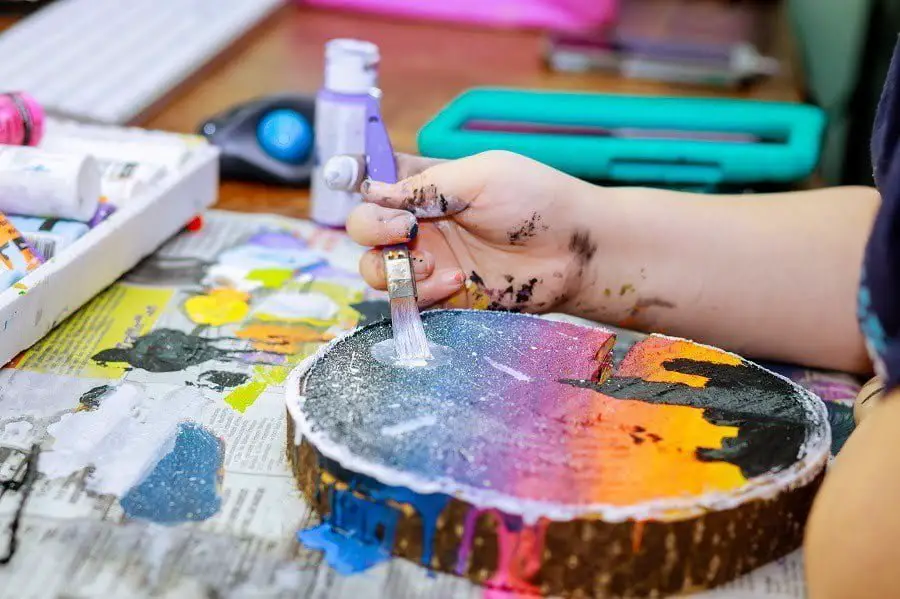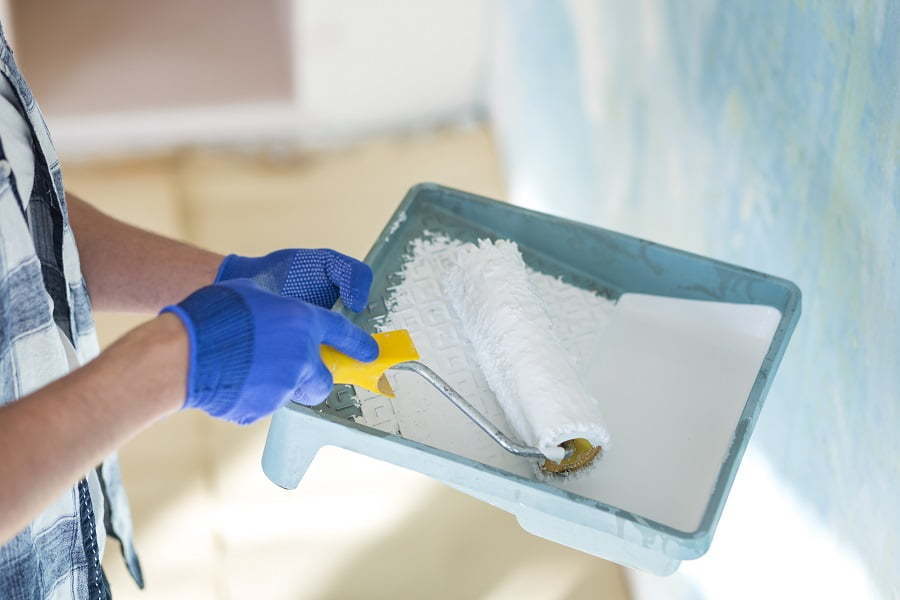Last updated on
Need to thin acrylic paint for your painting project? There are 2 main ways — water or medium. We have them covered here along with everything you need to know about thinning the paint. Read on!
Acrylic paints can seem quite daunting. Especially to those trying them out for the first time. In fact, many do-it-yourselfers are put off from trying acrylics at all because they are known to be difficult to work with. Hiring commercial painters are always a good idea. They deal with this on a larger scale.
This is mostly because of the sheer thickness of the paint. When you squeeze even a little bit of acrylic paint out of a tube, it can be alarming. Acrylic paint is so rich and thick that it seems impossible to paint within any smooth or appealing way.
That is why acrylic paint has to be thinned and prepared before it is used to paint. Once you understand how to thin acrylics and why they need to be thinned, it becomes a much more simple medium. Acrylic paints might seem intimidating but once you understand them they are quite simple.
Luckily, commercial painters are trained to use acrylics. This takes all the work out of thinning your paint yourself as a commercial painter can do it all for you. However, here are a few ways to thin your acrylics at home if you want to try your hand at it.
Table of Contents
Why Thin Acrylics

Acrylic paints are very thick and viscous in a way that oil paints and watercolors are not. This is because acrylic paints are made of an acrylic polymer emulsion instead of oil. They also have a coloring pigment to give acrylics that rich, thick color they are known for.
This makes the paint come out very thick and difficult to work with. It does, however, add pigment and richness that can be hard to find in any other paints. So instead of not using the beautiful but thick paint, you just have to thin it down to make it easier to work with.
Acrylic paint needs to be thinned whether you are painting your walls or painting a landscape. Large amounts of acrylic paints will take more thinning and be a longer process. This is why so many people choose to hire commercial painters for bigger projects.
Thinning your acrylic paint is much simpler than you might have been led to believe. The biggest problem you might encounter is adding too much thinner and ending up with a wash or glaze instead of a pigmented paint. Luckily, you will quickly figure out the ratios, and acrylic paints will become much less intimidating.
Water

As with latex paint, the first and most common acrylic thinner is just plain water. Unlike oil paints, acrylic paint is water-soluble which means the paint will break down if you add water to the mixture. This makes water an excellent thinner for acrylic paint.
The amount of water you add to your paint will make all the difference. If you add about thirty percent water or less to your paint, you will come out with more useable paint. If you add just the right amount of water to the acrylic, you will be able to create a consistency that behaves more like traditional latex paint.
If you add a significant amount of water you could end up with an almost translucent, watery paint. This is often called a “stain” it can be used to add a tint of color to an area or add light markings that regular paint might have been too thick or pigmented for.
Be careful when diluting your acrylics and the more you work with them the better you will get at finding the correct water to paint ratio. You can also use some techniques to thicken the paint if you get too overzealous with adding water.
Add your water to your acrylic paint slowly testing out the consistency and color as you go. Do not just pour water into your paint without measuring and testing first. This is a common mistake for people trying acrylics for the first time.
Try to hit a one to two ratios the first time you thin your acrylics, this applies to large amounts of acrylic paints as well. This will give you a workable paint and show you a starting off point for thinning your acrylic paint more or less from there. Thinning acrylics is only difficult if you jump in with no plan of measuring.
The more you work the acrylics the easier thinning them with water will get. There are experienced commercial painters who can just pour in water and mix that way as they go. The more you practice and understand how much water you need to get the color and texture you want, the easier painting with acrylics will become.
Acrylic Mediums

If you feel water is not the right method for you or you just want to try all of your options, there are products made specifically for thinning acrylic paints. These products are called mediums and they are sold by most paint companies who also sell acrylics. They are also recommended if you are using a particularly viscous acrylic paint.
You might see these products marketed as “flow improvers” and they will often have names with the word flow in the title. These products are made specifically to break down the binding agent, acrylic polymer emulsion, that makes acrylic paint so thick. This makes them excellent acrylic paint thinners.
A flow improver is usually quite expensive but there are painters who will tell you the product is worth the price. Because these mediums are created specifically for acrylic paint, they are often much easier to mix with acrylics than water is. This means you can pay less attention to your ratios and more attention to your painting.
Flow improvers also have the unique ability to get acrylic paints even thinner than water can. Instead of getting a “stain” at it’s thinnest, you can end up with a “glaze”. This will leave a thin, shiny layer over your canvas that is often a great starting point for an acrylic painting just like a “stain” would be.
One of the great things about flow improvers is the shine they leave in the paint as you go. Water breaks down your paint which is perfect for thinning and ending up with a more matte look. Flow improvers thin your paint and leave a shine that lasts and can add interest to your project.
Often it is recommended you start out using water as thinner because it is free and will give you a good idea of how to mix acrylic paint. However, if you are painting a whole room it might be best to start out with a flow improver.
As you get better with acrylics and want to start experimenting with style and texture investing in a flow improver might be worth the money. It depends on where you want to start and how much you are willing to spend upfront.
Another thing to consider is the longevity of your paint job. Acrylic paints crack easily if you have too light texture on top of thicker paint, or the paint is not being held together properly. It has been noted that paint thinned with water sometimes falls apart more quickly than paint thinned with a flow improver.
This does not mean an acrylic paint thinned with water will not last or is doomed to crack. It is simply a factor to consider when deciding which thinner you feel is best for your painting project. Both flow improvers and water will thin your acrylics and allow you to find new textures and colors in the paint.
More Complications

There are, of course, other reasons acrylic paints are considered difficult. One of the bigger fears is your paint cracking and ruining the whole project. This is a very real fear. Especially for people just starting with acrylic paint.
The general rule of acrylic painting is “fat over lean”. This is an easy way of saying your thinnest layer of paint needs to be the bottom layer. Each layer should get a bit thicker with your thickest layer being the top layer of paint.
If you have a thicker layer of paint underneath a thin layer, your thinner layer is likely to crack. This leaves unfixable cracks in your paint that can be very upsetting. Especially if you worked very hard and spent a lot of money to get your walls just right
As with all paints, you want to work carefully with acrylics. They are a beautiful medium that is well worth the work of learning how to use properly. The more you work with them and the more things you try the better you will become at working with acrylic paint.
The Takeaway
Acrylic paint needs to be thinned to be workable. The paint is too viscous on its own to be easy or enjoyable to work with. Luckily, acrylic paint thinner is easy to come by.
Simple water, as well as flow improvers, are the most common ways to thin acrylic paint. While water is free and commonly used, it also required careful measuring when mixing. Flow improvers are quite expensive but are easier to mix and leave results that shine.
No matter which thinner you use, make sure to pay attention to the general rules of acrylic paints. Thinning is important but it is not the only difficulty that makes acrylic paints intimidating to new users. And, whatever you do, do not forget to wash your paintbrush before the acrylics dry.




